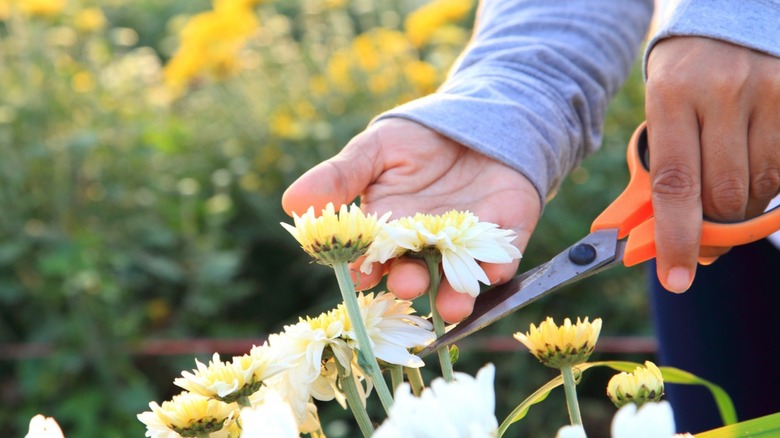Chrysanthemums are hardy flowering perennials (often grown as annuals) that give us their bright pops of color in the fall. These flowers are a favorite of gardeners practically everywhere, and chances are you’ll find them in all sorts of colors and sizes at your closest nursery. Deadheading your mums, or removing dried or old flowers, will allow you to get the most out of them. Performing this maintenance act in a certain way and at a specific time will help you become a garden professional.
Mums grown outdoors are usually the last to bloom and leave their colors with us before the winter sets in. They can be used in garden flowerbeds or as beautiful borders, and they attract lots of pollinators. If you’re growing yours as perennials and not treating them as annuals, you’ll want to plant them either in early spring or in the fall, six weeks prior to the first expected frost. Spring is probably best, due to the fact that they’ll have the warm season to develop a stronger root system for the future.
How to deadhead your mums

The best way to deadhead your mums like a garden pro is as easy as snapping your fingers. Pinching off the dead flower heads can be done outdoors, and all you need is your index finger and your (green) thumb to do it. All you’re trying to accomplish is a clean and simple break, cut, or snap-off of the deadhead, right where the next start of leaves are sprouting beneath it. You can also do this to leggy stems or stalks to promote bushiness and uniformity.
If you haven’t done this before, it might be a bigger job than you initially think, so you may also want to use garden shears. If you have multiple mums to deadhead, shears might make more sense to get the job done quickly. You’ll be able to cut multiple flower heads at once, and it will give new underlying buds a chance to bloom. However, this will temporarily give the mums a more sheared-off look, which some may not enjoy. Doing it by hand may produce a better result aesthetically. Either way, deadheading is important, as this will allow your mum to produce as many blooms as possible.
When to deadhead your mums and other tips

Watch your mums for blooms that start to become pale and die once they begin blooming in the fall. It’s easiest to take care of deadheads as they happen, and check on them often during the growing season. If you’re growing your mums as perennials, you can also deadhead them in the late spring and early summer, which will get them ready to bloom again in the fall. Stop deadheading once they’re completely finished flowering in late fall or early winter, otherwise you will expose the plant to the cold where it has been cut.
If you deadhead a large number of blooms or use shears for bigger jobs, make sure you time your pruning so that the plants get at least a couple hours of sunshine afterwards. Check the soil to make sure it’s moist, and refresh it with water if needed. Incidentally, it is sometimes called “major deadheading” when you cut back the plant all the way to the ground after it dies completely. After completing this task, make sure you dispose of the deadheads afterwards. Otherwise, they will create the perfect haven for slugs and snails to lay their eggs in, which are enemies of mums and can overtake and kill the plants. Lastly, lay some mulch over the soil in late fall to add some protection for the winter months.



